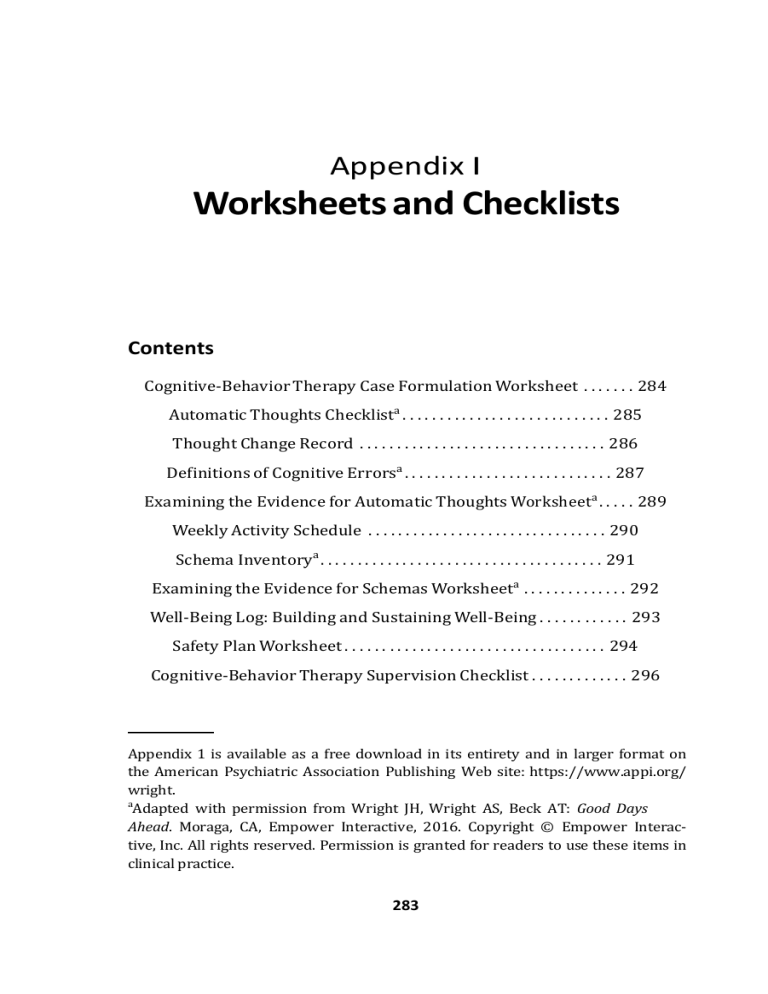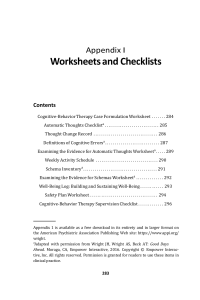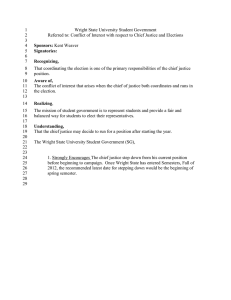
Appendix I Worksheets and Checklists Contents Cognitive-Behavior Therapy Case Formulation Worksheet . . . . . . . 284 Automatic Thoughts Checklista . . . . . . . . . . . . . . . . . . . . . . . . . . . . 285 Thought Change Record . . . . . . . . . . . . . . . . . . . . . . . . . . . . . . . . . 286 Definitions of Cognitive Errorsa . . . . . . . . . . . . . . . . . . . . . . . . . . . . 287 Examining the Evidence for Automatic Thoughts Worksheeta . . . . . 289 Weekly Activity Schedule . . . . . . . . . . . . . . . . . . . . . . . . . . . . . . . . 290 Schema Inventorya . . . . . . . . . . . . . . . . . . . . . . . . . . . . . . . . . . . . . . 291 Examining the Evidence for Schemas Worksheeta . . . . . . . . . . . . . . 292 Well-Being Log: Building and Sustaining Well-Being . . . . . . . . . . . . 293 Safety Plan Worksheet . . . . . . . . . . . . . . . . . . . . . . . . . . . . . . . . . . . 294 Cognitive-Behavior Therapy Supervision Checklist . . . . . . . . . . . . . 296 Appendix 1 is available as a free download in its entirety and in larger format on the American Psychiatric Association Publishing Web site: https://www.appi.org/ wright. a Adapted with permission from Wright JH, Wright AS, Beck AT: Good Days Ahead. Moraga, CA, Empower Interactive, 2016. Copyright © Empower Interactive, Inc. All rights reserved. Permission is granted for readers to use these items in clinical practice. 283 284 Learning Cognitive-Behavior Therapy Cognitive-Behavior Therapy Case Formulation Worksheet Patient Name: Date: Diagnoses/Symptoms: Formative Influences: Situational Issues: Biological, Genetic, and Medical Factors: Strengths/Assets: Treatment Goals: Event 1 Event 2 Event 3 Automatic Thoughts Automatic Thoughts Automatic Thoughts Emotions Emotions Emotions Behaviors Behaviors Behaviors Schemas: Working Hypothesis: Treatment Plan: Note. Available at: https://www.appi.org/wright. Appendix 1: Worksheets and Checklists 3 Automatic Thoughts Checklist Instructions: Place a check mark beside each negative automatic thought that you have had in the past 2 weeks. I should be doing better in life. He/she doesn’t understand me. I’ve let him/her down. I just can’t enjoy things anymore. Why am I so weak? I always keep messing things up. My life’s going nowhere. I can’t handle it. I’m failing. It’s too much for me. I don’t have much of a future. Things are out of control. I feel like giving up. Something bad is sure to happen. There must be something wrong with me. Note. Available at: https://www.appi.org/wright. Situation Automatic thought(s) a. Describe event leading to emotion or b. Stream of thoughts leading to emotion or c. Physiological sensations. a. Write automatic thought(s) that preceded emotion(s). b. Rate belief in automatic thought(s), 0%–100%. 286 Thought Change Record Emotion(s) Rational response Outcome a. Specify sad, anxious, angry, etc. b. Rate degree of emotion, 1%–100%. a. Identify cognitive errors. b. Write rational response to automatic thought(s). c. Rate belief in rational response, 0%–100%. a. Specify and rate subsequent emotion(s), 0%–100%. b. Describe changes in behavior. Learning Cognitive-Behavior Therapy Source. Adapted from Beck AT, Rush AJ, Shaw BF, et al.: Cognitive Therapy of Depression. New York, Guilford, 1979, pp. 164–165. Reprinted with permission of Guilford Press. Available at: https://www.appi.org/wright. Appendix 1: Worksheets and Checklists 287 Definitions of Cognitive Errors Selective abstraction (sometimes called ignoring the evidence or the mental filter) A conclusion is drawn after looking at only a small portion of the available information. Salient data are screened out or ignored in order to confirm the person’s biased view of the situation. Example: A depressed man with low self-esteem doesn’t receive a holiday card from an old friend. He thinks, “I’m losing all my friends; nobody cares about me anymore.” He is ignoring the evidence that he has received a number of other cards, his old friend has sent him a card every year for the past 15 years, his friend has been busy this past year with a move and a new job, and he still has good relationships with other friends. Arbitrary inference Coming to a conclusion in the face of contradictory evidence or in the absence of evidence. Example: A woman with fear of elevators is asked to predict the chances that an elevator will fall if she rides in it. She replies that the chances are 10% or more that the elevator will fall to the ground and she will be injured. Many people have tried to convince her that the chances of a catastrophic elevator accident are negligible. Overgeneralization A conclusion is made about one or more isolated incidents and then is extended illogically to cover broad areas of functioning. Example: A depressed college student gets a B on a test. He considers this unsatisfactory. He overgeneralizes when he has these automatic thoughts: “I’m in trouble in this class....I’m falling short everywhere in my life....I can’t do anything right.” Magnification and minimization The significance of an attribute, event, or sensation is exaggerated or minimized. Example: A woman with panic disorder starts to feel light-headed during the onset of a panic attack. She thinks, “I’ll faint. . . . I might have a heart attack or a stroke.” Personalization External events are related to oneself when there is little evidence for doing so. Excessive responsibility or blame is taken for negative events. 288 Learning Cognitive-Behavior Therapy Example: There has been an economic downturn, and a previously successful business is now struggling to meet the annual budget. Layoffs are being considered. A host of factors have led to the budget crisis, but one of the managers thinks, “It’s all my fault. . . . I should have seen this coming and done something about it. . . . I’ve failed everyone in the company.” Absolutistic thinking (also called all-or-nothing thinking) Judgments about oneself, personal experiences, or others are placed into one of two categories: all bad or all good; total failure or complete success; completely flawed or absolutely perfect. Example: Dan, a man with depression, compares himself with Ed, a friend who appears to have a good marriage and whose children are doing well in school. Although the friend has a fair amount of domestic happiness, his life is far from ideal. Ed has troubles at work, financial strains, and physical ailments, among other difficulties. Dan is engaging in absolutistic thinking when he tells himself, “Ed has everything going for him....I have nothing.” Note. Available at: https://www.appi.org/wright. 289 Appendix 1: Worksheets and Checklists Examining the Evidence for Automatic Thoughts Worksheet Instructions: 1. Identify a negative or troubling automatic thought. 2. Then list all the evidence that you can find that either supports (“evidence for”) or disproves (“evidence against”) the automatic thought. 3. After trying to find cognitive errors in the “evidence for” column, you can write revised or alternative thoughts at the bottom of the page. Automatic thought: Evidence for automatic thought: Evidence against automatic thought: 1. 1. 2. 2. 3. 3. 4. 4. 5. 5. Cognitive errors: Alternative thoughts: Note. Available at: https://www.appi.org/wright. 290 Weekly Activity Schedule Instructions: Write down your activities for each hour and then rate them on a scale of 0–10 for mastery (m) or degree of accomplishment and for pleasure (p) or amount of enjoyment you experienced. A rating of 0 would mean that you had no sense of mastery or pleasure. A rating of 10 would mean that you experienced maximum mastery or pleasure. Sunday Monday Tuesday Wednesday Thursday Friday Saturday 8:00 A.M. 9:00 A.M. 10:00 A.M. 12:00 P.M. 1:00 P.M. 2:00 P.M. 3:00 P.M. 4:00 P.M. 5:00 P.M. 6:00 P.M. 7:00 P.M. 8:00 P.M. 9:00 P.M. Note. Available at: https://www.appi.org/wright. Learning Cognitive-Behavior Therapy 11:00 A.M. 291 Appendix 1: Worksheets and Checklists Schema Inventory Instructions: Use this checklist to search for possible underlying rules of thinking. Place a check mark beside each schema that you think you may have. Healthy Schemas No matter what happens, I can manage somehow. If I work hard at something, I can master it. I’m a survivor. Others trust me. I’m a solid person. People respect me. They can knock me down, but they can’t knock me out. I care about other people. If I prepare in advance, I usually do better. I deserve to be respected. I like to be challenged. There’s not much that can scare me. I’m intelligent. I can figure things out. I’m friendly. I can handle stress. The tougher the problem, the tougher I become. I can learn from my mistakes and be a better person. I’m a good spouse (and/or parent, child, friend, lover). Everything will work out all right. Maladaptive Schemas I must be perfect to be accepted. If I choose to do something, I must succeed. I’m stupid. Without a woman (man), I’m nothing. I’m a fake. Never show weakness. I’m unlovable. If I make one mistake, I’ll lose everything. I’ll never be comfortable around others. I can never finish anything. No matter what I do, I won’t succeed. The world is too frightening for me. Others can’t be trusted. I must always be in control. I’m unattractive. Never show your emotions. Other people will take advantage of me. I’m lazy. If people really knew me, they wouldn’t like me. To be accepted, I must always please others. Note. Available at: https://www.appi.org/wright. 292 Learning Cognitive-Behavior Therapy Examining the Evidence for Schemas Worksheet Instructions: 1. Identify a negative or maladaptive schema that you would like to change. Write it down on this form. 2. Write down any evidence that either supports or disproves this schema. 3. Look for cognitive errors in the evidence for the maladaptive schema. 4. Finally, note your ideas for changing the schema and your plans for putting these ideas into action. Schema I want to change: Evidence for this schema: Evidence against this schema: 1. 1. 2. 2. 3. 3. 4. 4. 5. 5. Cognitive errors: Now that I’ve examined the evidence, my degree of belief in the schema is: Ideas I have for modifications to this schema: Actions I will take now to change my schema and act in a healthier way: Note. Available at: https://www.appi.org/wright. Situation Experiences and feelings of well-being Interfering thoughts and/or behaviors Observer 293 Note. Available at: https://www.appi.org/wright. Intensity (0–100) Appendix 1: Worksheets and Checklists Well-Being Log: Building and Sustaining Well-Being 294 Learning Cognitive-Behavior Therapy Safety Plan Worksheet Step 1: Warning signs: 1. 2. 3. Step 2: Internal coping strategies— Things I can do to take my mind off my problems without contacting another person: 1. 2. 3. Step 3: People and social settings that provide distraction: 1. Name Phone 2. Name Phone 3. Place 4. Place Step 4: People whom I can ask for help: 1. Name Phone 2. Name Phone 3. Name Phone Step 5: Professionals or agencies I can contact during a crisis: 1. Clinician/Agency Name_ Phone Clinician Phone Clinician Pager or Emergency Contact # 2. Clinician/Agency Name Pager or Emergency Contact # 3. Local Emergency Emergency Department Emergency Department Phone 4. Suicide Prevention Lifeline Phone: 1-800-273-TALK (8255) 5. Other: Note. Available at: https://www.appi.org/wright. Department Address 295 Appendix 1: Worksheets and Checklists Step 6: Making the environment safe: 1. 2. 3. Step 7: Reasons for living—The things that are most important to me and worth living for are: 1. 4. 2. 5. 3. 6. Source. Reproduced with permission (© 2008, 2012, 2016 Barbara Stanley, Ph.D., and Gregory K. Brown, Ph.D.). To register to use this form and for additional training resources, go to: www.suicidesafetyplan.com. Note. Available at: https://www.appi.org/wright. 296 Learning Cognitive-Behavior Therapy Cognitive-Behavior Therapy Supervision Checklista Therapist Supervisor Date Instructions: Use this checklist to monitor and evaluate competencies in CBT. Listed in Part A are competencies that should typically be demonstrated in each session. Part B contains competencies that may be demonstrated over a course of therapy or therapies. The checklist is not intended for evaluation of performance in first or last sessions. Part A: Competencies that should typically be demonstrated in each session Competency N/A 1. Maintains collaborative empirical alliance Needs Did not Superior Satisfactory improvement attempt or 2. Expresses appropriate empathy, genuineness 3. Demonstrates accurate understanding 4. Maintains appropriate professionalism and boundaries 5. Elicits and gives appropriate feedback 6. Demonstrates knowledge of CBT model 7. Demonstrates ability to use guided discovery 8. Effectively sets agenda and structures session 9. Reviews and assigns useful homework 10. Identifies automatic thoughts and/or beliefs (schemas) 11. Modifies automatic thoughts and/or beliefs (schemas) Note. Available at: https://www.appi.org/wright. Appendix 1: Worksheets and Checklists Competency N/A 12. Utilizes behavioral intervention or assists patient with problem solving 297 Needs Did not Superior Satisfactory improvement attempt or 13. Applies CBT methods in flexible manner that meets needs of patient Part B: Competencies that may be demonstrated over a course of therapy or therapies Needs Did not Competency Superior Satisfactory improvement attempt or N/A 1. Sets goals and plans treatment based on CBT formulation 2. Educates patient about CBT model and/or therapy interventions 3. Demonstrates ability to use thought record or other structured method of responding to dysfunctional cognitions 4. Can utilize activity or pleasant events scheduling 5. Can utilize exposure and response prevention or graded task assignment 6. Can utilize relaxation and/or stress management techniques 7. Can utilize CBT relapse prevention methods Comments: a Checklist developed by Donna Sudak, M.D., Jesse H. Wright, M.D., Ph.D., David Bienenfeld, M.D., and Judith Beck, Ph.D., 2001. Note. Available at: https://www.appi.org/wright.






